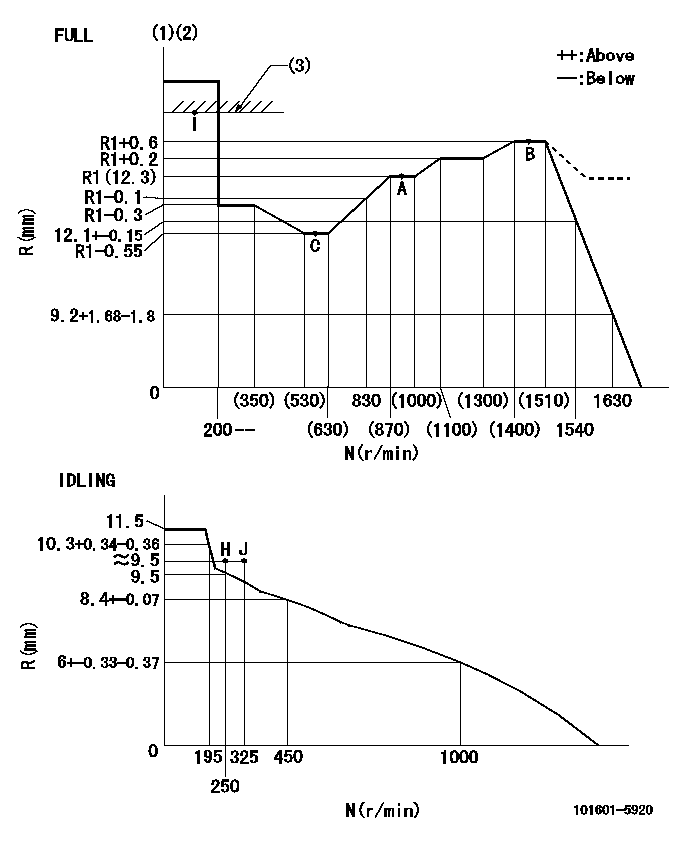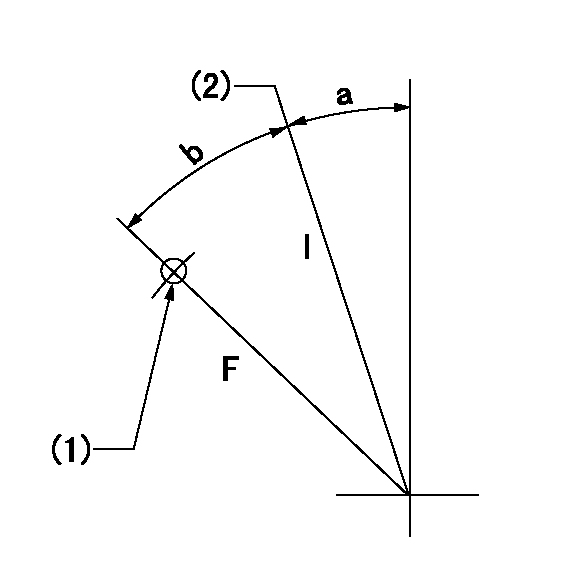Information injection-pump assembly
BOSCH
F 019 Z10 497
f019z10497
ZEXEL
101601-5920
1016015920
HINO
220007910A
220007910a

Rating:
Service parts 101601-5920 INJECTION-PUMP ASSEMBLY:
1.
_
7.
COUPLING PLATE
8.
_
9.
_
11.
Nozzle and Holder
236002373A
12.
Open Pre:MPa(Kqf/cm2)
19.6(200)
15.
NOZZLE SET
Cross reference number
BOSCH
F 019 Z10 497
f019z10497
ZEXEL
101601-5920
1016015920
HINO
220007910A
220007910a
Zexel num
Bosch num
Firm num
Name
Calibration Data:
Adjustment conditions
Test oil
1404 Test oil ISO4113 or {SAEJ967d}
1404 Test oil ISO4113 or {SAEJ967d}
Test oil temperature
degC
40
40
45
Nozzle and nozzle holder
105780-8140
Bosch type code
EF8511/9A
Nozzle
105780-0000
Bosch type code
DN12SD12T
Nozzle holder
105780-2080
Bosch type code
EF8511/9
Opening pressure
MPa
17.2
Opening pressure
kgf/cm2
175
Injection pipe
Outer diameter - inner diameter - length (mm) mm 6-2-600
Outer diameter - inner diameter - length (mm) mm 6-2-600
Overflow valve
131424-8320
Overflow valve opening pressure
kPa
108
88
128
Overflow valve opening pressure
kgf/cm2
1.1
0.9
1.3
Tester oil delivery pressure
kPa
157
157
157
Tester oil delivery pressure
kgf/cm2
1.6
1.6
1.6
Direction of rotation (viewed from drive side)
Left L
Left L
Injection timing adjustment
Direction of rotation (viewed from drive side)
Left L
Left L
Injection order
1-4-2-6-
3-5
Pre-stroke
mm
4.3
4.27
4.33
Beginning of injection position
Governor side NO.1
Governor side NO.1
Difference between angles 1
Cal 1-4 deg. 60 59.75 60.25
Cal 1-4 deg. 60 59.75 60.25
Difference between angles 2
Cyl.1-2 deg. 120 119.75 120.25
Cyl.1-2 deg. 120 119.75 120.25
Difference between angles 3
Cal 1-6 deg. 180 179.75 180.25
Cal 1-6 deg. 180 179.75 180.25
Difference between angles 4
Cal 1-3 deg. 240 239.75 240.25
Cal 1-3 deg. 240 239.75 240.25
Difference between angles 5
Cal 1-5 deg. 300 299.75 300.25
Cal 1-5 deg. 300 299.75 300.25
Injection quantity adjustment
Adjusting point
-
Rack position
12.3
Pump speed
r/min
950
950
950
Average injection quantity
mm3/st.
82.6
81
84.2
Max. variation between cylinders
%
0
-3.5
3.5
Basic
*
Fixing the rack
*
Standard for adjustment of the maximum variation between cylinders
*
Injection quantity adjustment_02
Adjusting point
H
Rack position
9.5+-0.5
Pump speed
r/min
250
250
250
Each cylinder's injection qty
mm3/st.
15.4
14.4
16.4
Fixing the rack
*
Standard for adjustment of the maximum variation between cylinders
*
Injection quantity adjustment_03
Adjusting point
A
Rack position
R1(12.3)
Pump speed
r/min
950
950
950
Average injection quantity
mm3/st.
82.6
81.6
83.6
Basic
*
Fixing the lever
*
Injection quantity adjustment_04
Adjusting point
B
Rack position
R1+0.6
Pump speed
r/min
1450
1450
1450
Average injection quantity
mm3/st.
88.8
84.8
92.8
Fixing the lever
*
Injection quantity adjustment_05
Adjusting point
C
Rack position
R1-0.55
Pump speed
r/min
580
580
580
Average injection quantity
mm3/st.
69.2
65.2
73.2
Fixing the lever
*
Injection quantity adjustment_06
Adjusting point
I
Rack position
-
Pump speed
r/min
100
100
100
Average injection quantity
mm3/st.
136
136
146
Fixing the lever
*
Rack limit
*
Timer adjustment
Pump speed
r/min
950--
Advance angle
deg.
0
0
0
Load
1/4
Remarks
Start
Start
Timer adjustment_02
Pump speed
r/min
900
Advance angle
deg.
0.3
Load
1/4
Timer adjustment_03
Pump speed
r/min
(1000)
Advance angle
deg.
1.5
1.2
1.8
Load
4/4
Remarks
Measure the actual speed.
Measure the actual speed.
Timer adjustment_04
Pump speed
r/min
1240+50
Advance angle
deg.
1.5
1.2
1.8
Load
4/4
Timer adjustment_05
Pump speed
r/min
1450-50
Advance angle
deg.
5
4.7
5.3
Load
4/4
Remarks
Finish
Finish
Test data Ex:
Governor adjustment

N:Pump speed
R:Rack position (mm)
(1)Torque cam stamping: T1
(2)Tolerance for racks not indicated: +-0.05mm.
(3)RACK LIMIT
----------
T1=G89
----------
----------
T1=G89
----------
Speed control lever angle

F:Full speed
I:Idle
(1)Use the hole at R = aa
(2)Stopper bolt set position 'H'
----------
aa=46mm
----------
a=34deg+-5deg b=38deg+-3deg
----------
aa=46mm
----------
a=34deg+-5deg b=38deg+-3deg
Stop lever angle

N:Pump normal
S:Stop the pump.
----------
----------
a=28deg+-5deg b=40deg+-5deg
----------
----------
a=28deg+-5deg b=40deg+-5deg
Timing setting

(1)Pump vertical direction
(2)Coupling's key groove position at No 1 cylinder's beginning of injection
(3)-
(4)-
----------
----------
a=(20deg)
----------
----------
a=(20deg)
Information:
Your truck may not have the same or all of the gauges as shown in the illustrations. The illustrations shown are of typical gauges.Gauges provide a "look" inside the engine. Be sure they are in good working order. You can determine what is the "normal" operating range by observing your gauges over a period of time.Noticeable changes in gauge readings are indicative of potential gauge or engine problems. This also applies to gauge readings that have changed significantly but are still within specifications. The cause of any sudden or significant change in the readings should be determined and corrected. Contact your Caterpillar dealer for assistance as needed. Oil Pressure - Indicates engine oil pressure. The oil pressure should be between 40 and 88 psi (275 and 606 kPa) when the engine is running at rated engine speed, with SAE 15W-40 oil, at operating temperature. A lower pressure is normal at low idling speed.
If no oil pressure is indicated, stop the engine. Engine damage can result.
Water Temperature - Indicates engine coolant temperture. It should normally indicate between 170°F (77°C) and 208°F (98°C). Somewhat higher temperature may occur under certain conditions. Maximum allowable temperature is 210°F (99°C) with the cooling system pressurized. Ammeter - Indicates the amount of charge or discharge in the battery charging circuit. Normal operation of the indicator should be slightly to the positive (right) side of "0" (zero).With the engine running, during normal operation, if the indicator is constantly to the negative (left) side of "0" (zero) or shows excessive charge, have the charging system checked for malfunction. Tachometer - Indicates engine rpm (speed). The engine can be operated at high idle without damage, but should not be allowed to overspeed. Overspeeding when downshifting, goin downhill, etc., can result in serious damage to your engine.
Do not exceed maximum braking rpm in any situation.
Fuel Level - Indicates fuel level in the fuel tank. Electrically operated, it registers only when the key switch is ON. Fuel Pressure - Indicates fuel pressure to the injection pump. The indicator should register in the NORMAL (green) range.If the indicator moves to the OUT position or registers below 23 psi (160 kPa) when equipped with a numerical gauge, the engine will not operate properly. In most cases this is caused by a plugged fuel filter. Service Hour Meter - Indicates the total number of clock hours the engine has operated.
If no oil pressure is indicated, stop the engine. Engine damage can result.
Water Temperature - Indicates engine coolant temperture. It should normally indicate between 170°F (77°C) and 208°F (98°C). Somewhat higher temperature may occur under certain conditions. Maximum allowable temperature is 210°F (99°C) with the cooling system pressurized. Ammeter - Indicates the amount of charge or discharge in the battery charging circuit. Normal operation of the indicator should be slightly to the positive (right) side of "0" (zero).With the engine running, during normal operation, if the indicator is constantly to the negative (left) side of "0" (zero) or shows excessive charge, have the charging system checked for malfunction. Tachometer - Indicates engine rpm (speed). The engine can be operated at high idle without damage, but should not be allowed to overspeed. Overspeeding when downshifting, goin downhill, etc., can result in serious damage to your engine.
Do not exceed maximum braking rpm in any situation.
Fuel Level - Indicates fuel level in the fuel tank. Electrically operated, it registers only when the key switch is ON. Fuel Pressure - Indicates fuel pressure to the injection pump. The indicator should register in the NORMAL (green) range.If the indicator moves to the OUT position or registers below 23 psi (160 kPa) when equipped with a numerical gauge, the engine will not operate properly. In most cases this is caused by a plugged fuel filter. Service Hour Meter - Indicates the total number of clock hours the engine has operated.